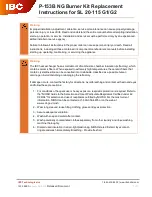
4 Set-up
6
Installation and maintenance instructions uniSTOR 0020221297_05
3.4
Hot Water Association
Vaillant is a full member of the Hot Water Association and
promotes the scheme in association with its cylinder range.
Details are available on the web site www.vaillant.co.uk
4
Set-up
4.1
Observing the requirements for the
product's installation site
Caution.
Material damage due to frost
If the water in the system freezes, there is
a risk of damage to the domestic hot water
cylinder.
▶
Install the cylinder in a dry, permanently
frost-free room.
Caution.
Material damage due to escaping water
In the event of damage, water may escape
from the cylinder.
▶
Select the installation location so that, in
the event of damage, large volumes of
water can be drained safely (e.g. into a
floor drain).
Caution.
Material damage due to high load
When filled, the cylinder may damage the
ground on which it stands due to its weight.
▶
Take into consideration the weight of the
filled cylinder and the load-bearing capa-
city of the floor.
▶
If required, reinforce the installation area.
Select a sensible installation site and take into consideration
the routing of the pipework system.
Install the cylinder as close as possible to the heat generator
in order to minimise heat losses.
Set up the product in a suitable location in a room and, when
doing so, pay attention to the following points:
–
Plan the installation of the tundish (
–
The installation surface must be even and have sufficient
load-bearing capacity to support the operating weight of
the product.
–
The installation site must be frost-free.
–
Install the product in such a way that the thermostat and
immersion heater can be accessed easily.
–
Leave sufficient space around the product for installing,
maintaining and replacing the expansion vessel.
To prevent heat losses, the pipework system must have heat
insulation in accordance with the applicable energy-saving
regulations.
4.2
Transport
Caution.
Risk of material damage caused by incor-
rect transport.
The components attached to the cylinder
must not be used to transport the cylinder.
Otherwise there is a risk that the cylinder
could malfunction.
▶
Do not use the components attached to
the cylinder to transport it.
Always transport the unit as illustrated above.
Never transport the unit while it is horizontal.







































